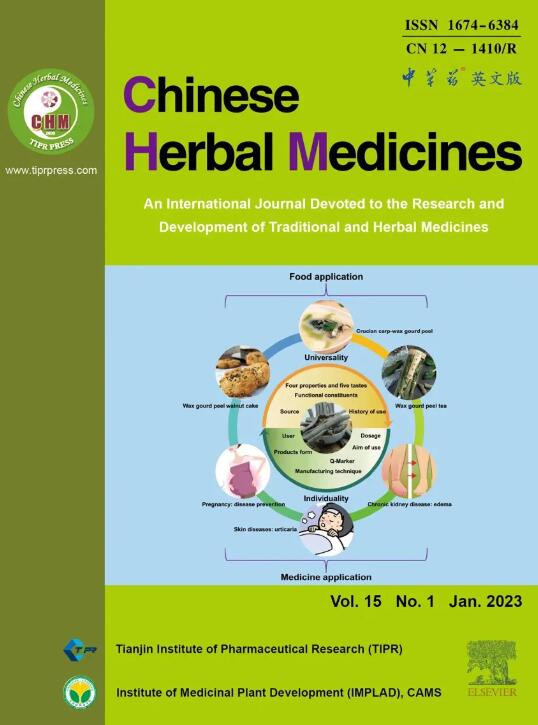代谢组学与网络药理学相结合,揭示了泽泻对过敏性哮喘大鼠的抗哮喘作用
IF 8.9
4区 医学
Q1 CHEMISTRY, MEDICINAL
引用次数: 0
摘要
方法 本研究用卵清蛋白(OVA)诱导大鼠哮喘模型,并用苞芦煎剂治疗大鼠,观察肺组织的病理变化,并对支气管肺泡灌洗液中的嗜酸性粒细胞(EOS)和白细胞(WBC)进行定量分析。观察了肺组织的病理变化,并对支气管肺泡灌洗液中的嗜酸性粒细胞(EOS)和白细胞(WBC)进行了定量。此外,还评估了 OVA 诱导的哮喘相关因子的血清水平。利用 1H NMR 光谱血清代谢组学方法确定了不同的代谢物及其相关代谢途径。UPLC-QE-MS/MS 与网络药理学相结合,预测了 DBJJ 抗哮喘作用的核心靶点和途径。利用代谢组学和网络药理学的综合方法研究了 DBJJ 的抗哮喘特性。结果服用DBJJ可有效缓解OVA诱导的肺组织病理学变化,并减少BALF中EOS和WBC的数量。此外,DBJJ 还抑制了 OVA 诱导的 TNF-α、IL-18、Ig-E、EOS、IL-1β、MDA、VEGF-A 和 TGF-β1 的升高。代谢组学分析共发现了 21 个生物标记物和 10 条通路。通过UPLC-QE-MS/MS鉴定了29种化合物,其中13种活性成分是通过口服有效性和Caco-2细胞渗透性筛选的,预测了120个靶点和173条KEGG通路。结合代谢组学和网络药理学分析发现,DBJJ的主要成分阿魏酸和熊果酸对DAO和NOS2等4个靶点及其相关代谢产物和通路产生作用。DBJJ 的活性成分与 DAO 和 NOS2 有很高的结合亲和力。此外,还观察到 DBJJ 降低了 NOS2、MAPK 和 STAT3 的蛋白表达和磷酸化水平。这种效果可归因于阿魏酸和熊果酸等主要成分对 NOS2、MAPK 和 STAT3 等多个靶点的调节作用。本文章由计算机程序翻译,如有差异,请以英文原文为准。
Metabolomics combined with network pharmacology reveals anti-asthmatic effects of Nepeta bracteata on allergic asthma rats
Objective
To investigate the mechanisms that underlie the anti-asthmatic effects of Nepeta bracteata (DBJJ, Dabao Jingjie in Chinese) in rats by integrating metabolomics and network pharmacology.
Methods
In this study, the rat model of asthma was induced by ovalbumin (OVA), and the rats were treated with a decoction of N. bracteata. Pathological changes in lung tissue were observed, and the quantification of eosinophils (EOS) and white blood cells (WBC) in bronchoalveolar lavage fluid was performed. Furthermore, the serum levels of asthma-related factors induced by OVA were assessed. 1H NMR spectroscopy serum metabolomics method was utilized to identify differential metabolites and their associated metabolic pathways. UPLC-QE-MS/MS combined with network pharmacology was employed to predict the core targets and pathways of DBJJ in its action against asthma. The anti-asthmatic properties of DBJJ were investigated using an integrated approach of metabolomics and network pharmacology. The findings were validated through molecular docking and Western blotting analysis of the key targets.
Results
The administration of DBJJ effectively alleviated OVA-induced lung histopathological changes and decreased the number of EOS and WBC in BALF. Additionally, DBJJ inhibited the OVA-induced elevation of TNF-α, IL-18, Ig-E, EOS, IL-1β, MDA, VEGF-A, and TGF-β1. A total of 21 biomarkers and 10 pathways were found by metabolomics analysis. A total of 29 compounds were identified by UPLC-QE-MS/MS, in which 13 active components were screened by oral availability and Caco-2 cell permeability, the 120 targets and 173 KEGG pathways were predicted. The integration of metabolomics and network pharmacological analysis revealed that DBJJ's main constituents, including ferulic acid and ursolic acid, exerted their effects on four targets, namely DAO and NOS2, as well as their associated metabolites and pathways. The active constituents of DBJJ demonstrated a high binding affinity towards DAO and NOS2. Furthermore, DBJJ was observed to decrease the protein expression and phosphorylation levels of NOS2, MAPK, and STAT3.
Conclusion
The administration of DBJJ demonstrates notable anti-asthma properties in rats with allergic asthma. This effect can be attributed to the modulation of various targets, including NOS2, MAPK, and STAT3, by primary constituents such as ferulic acid and ursolic acid.
求助全文
通过发布文献求助,成功后即可免费获取论文全文。
去求助
来源期刊

Chinese Herbal Medicines
CHEMISTRY, MEDICINAL-
CiteScore
4.40
自引率
5.30%
发文量
629
审稿时长
10 weeks
期刊介绍:
Chinese Herbal Medicines is intended to disseminate the latest developments and research progress in traditional and herbal medical sciences to researchers, practitioners, academics and administrators worldwide in the field of traditional and herbal medicines. The journal's international coverage ensures that research and progress from all regions of the world are widely included.
CHM is a core journal of Chinese science and technology. The journal entered into the ESCI database in 2017, and then was included in PMC, Scopus and other important international search systems. In 2019, CHM was successfully selected for the “China Science and Technology Journal Excellence Action Plan” project, which has markedly improved its international influence and industry popularity. CHM obtained the first impact factor of 3.8 in Journal Citation Reports (JCR) in 2023.
 求助内容:
求助内容: 应助结果提醒方式:
应助结果提醒方式:


